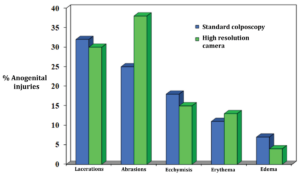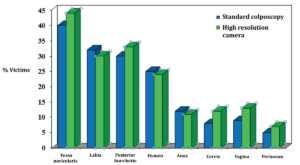Advances in Emergency Medicine and Gynecology: Enhancing Forensic Documentation with High-Resolution Imaging
Introduction
Emergency Medicine and Gynecology play critical roles in addressing and documenting the aftermath of sexual assault, a deeply traumatic experience that leaves both physical and emotional scars. High-quality forensic documentation, particularly for anogenital injuries, is vital for providing medical care and supporting victims in legal proceedings. This post explores the comparative effectiveness of traditional colposcopy versus high-resolution camera systems in documenting injuries in sexual assault cases.
Forensic Documentation: The Intersection of Emergency Medicine and Gynecology
The documentation of injuries has long been a cornerstone of both Emergency Medicine and Gynecology. Traditionally, colposcopy has been the gold standard for identifying and photographing anogenital injuries. This technique, introduced into forensic settings in the 1980s, allows clinicians to visualize microtrauma and document physical evidence with remarkable precision.
However, advancements in imaging technology have introduced newer high-resolution camera systems that promise even greater accuracy and detail. These systems not only enhance medical evaluations but also strengthen the evidentiary value of documentation in judicial contexts.
Colposcopy: A Legacy in Forensic Evaluation
Colposcopy offers magnification and nuclear staining to identify injuries that are invisible to the naked eye. Studies have demonstrated its efficacy in detecting injuries resulting from sexual assault, making it an indispensable tool in forensic gynecology. Key features of colposcopy include:
- Magnification of up to 40x for detailed visualization.
- The ability to capture digital photographs for forensic use.
- Integration with toluidine blue staining to highlight microtrauma.
Despite its advantages, colposcopy has limitations, including high costs and steep learning curves for clinicians. Additionally, interobserver variability in interpreting images can affect the reliability of findings.
High-Resolution Imaging: A Game-Changer in Forensic Medicine
High-resolution camera systems, such as the Secure Digital Forensic Imaging (SDFI) system, represent a significant leap forward in forensic documentation. These cameras offer:
- Superior image clarity with resolutions 7,813% higher than earlier colposcopic systems.
- Forensic tools for image management and analysis.
- Enhanced portability and ease of use compared to traditional colposcopes.
A recent study comparing colposcopy with high-resolution imaging systems found that the latter detected significantly more anogenital injuries, particularly microtrauma. This suggests that high-resolution systems may set a new standard for forensic evaluations in Emergency Medicine and Gynecology.
Study Insights: Comparing Imaging Techniques
A retrospective study at a nurse examiner clinic evaluated 547 sexual assault survivors over three years. The findings revealed critical differences between the two imaging techniques:
- Detection Rates: High-resolution systems identified more injuries (mean 2.4 per patient) compared to colposcopy (mean 1.9 per patient).
- Type of Injuries: The additional injuries detected were primarily superficial abrasions or microtrauma.
- Clinical Relevance: While microtrauma may not always have clinical significance, its documentation can provide crucial evidence in legal contexts.
 Figure 1: Types of anogenital trauma, classified according to the TEARS system
Figure 1: Types of anogenital trauma, classified according to the TEARS system
This study underscores the importance of technological advancements in Emergency Medicine and Gynecology for improving patient care and judicial outcomes.
 Figure 2: Location and frequency of injury in patients with anogenital findings
Figure 2: Location and frequency of injury in patients with anogenital findings
Challenges and Ethical Considerations
Despite their benefits, high-resolution systems raise important ethical and operational questions:
- Accessibility: High costs may limit the adoption of these systems in resource-constrained settings.
- Training: Effective use of high-resolution cameras requires specialized training for clinicians.
- Privacy: Enhanced imaging capabilities necessitate rigorous protocols to protect patient privacy.
Addressing these challenges is essential for integrating high-resolution imaging into mainstream forensic practice.
Implications for Emergency Medicine and Gynecology
The adoption of high-resolution imaging systems has far-reaching implications for Emergency Medicine and Gynecology:
- Improved Care: Enhanced imaging allows for more accurate assessments, leading to better medical outcomes.
- Legal Support: Detailed documentation strengthens cases against perpetrators and supports victims in seeking justice.
- Professional Development: The integration of new technologies necessitates ongoing education and training for clinicians.
Conclusion
Emergency Medicine and Gynecology are at the forefront of advancing forensic documentation through innovative imaging technologies. The shift from traditional colposcopy to high-resolution camera systems represents a transformative change, promising better outcomes for patients and more robust evidence for legal proceedings.
As we continue to explore these advancements, it is crucial to address challenges related to cost, training, and privacy. By doing so, we can ensure that these technologies serve as powerful tools in the fight against sexual violence, fostering hope and healing for survivors.
Lorem ipsum dolor sit amet, consectetur adipiscing elit. Ut elit tellus, luctus nec ullamcorper mattis, pulvinar dapibus leo.
